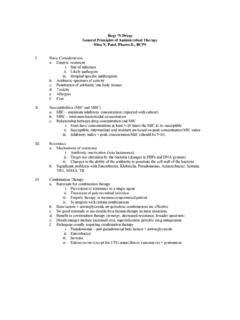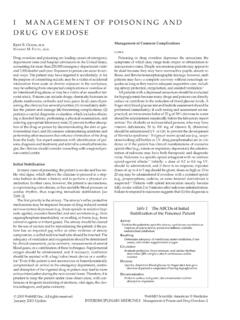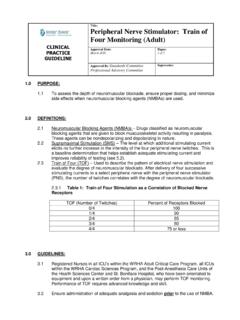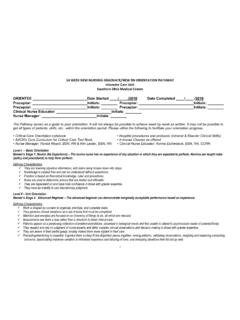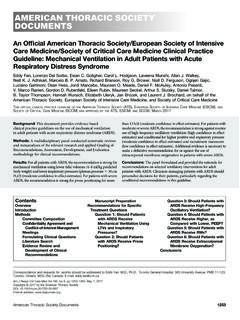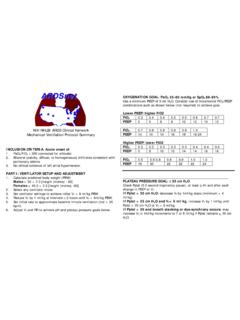Transcription of Sedation, Analgesia, and Paralysis in the Intensive Care ...
1 Sedation, Analgesia, and Paralysis in the Intensive care Unit Cathy L. Lawson, PharmD, BCPS Hina N. Patel, PharmD, BCPS I. Benzodiazepines A. Used to relieve anxiety/agitation, prevent withdrawal (alcohol, benzodiazepine), treat seizures/status epilepticus, provide sedation/promote sleep, amnestic effects and in conjunction with patients receiving neuromuscular blocking agents (NMBAs) since they possess no analgesic or sedative properties. B. Midazolam may be used for the short-term (<72 hours) treatment of anxiety. Long term administration results in a prolongation of the clinical effects of the drug. C. Lorazepam is the preferred agent for the prolonged treatment (>72 hours) of anxiety in the critically ill adult1 Compared with midazolam, it has a slower onset of action, causes less hypotension, is equally effective and has a longer duration of action.
2 Benzodiazepine Onset of Action Half-life Active Metabolites Diazepam (Valium ) very fast 10 80 hours yes Chlordiazepoxide (Librium ) intermediate 5 30 hours yes Clonazepam (Klonopin ) intermediate 18 50 hours no Lorazepam (Ativan ) fast 10 20 hours no Midazolam (Versed ) very fast 1 5 hours no D. Benzodiazepines may be given as needed (PRN) IV boluses, as scheduled IV boluses, as a continuous infusion or orally scheduled around the clock. E. Adverse effects include oversedation, prolonged sedation and hypotension. Some patients may exhibit a paradoxical reaction. Benzodiazepines have little effect on respiratory drive when given in therapeutic doses.
3 II. Opioid Analgesics A. Primarily used to relieve pain, but also exhibits some sedative properties. May be used to decrease the discomfort or cough associated with endotracheal tube placement and suction. Is used in conjunction with NMBAs since they possess no analgesic or sedative properties. B. Morphine is the preferred analgesic agent for critically ill Fentanyl is used primarily in the MICU because it is less likely to produce cardiovascular side effects such as hypotension and is no more expensive than morphine. It may be used safely in patients with an allergy to morphine. C. Meperidine (Demerol ) is not recommended because the active metabolite (normeperidine) may accumulate (especially in patients with renal insufficiency) and produce central nervous system excitation.
4 D. Adverse effects of opioids include respiratory depression, hypotension (secondary to direct vasodilation and histamine release) and gastrointestinal slowing. Opioid Onset of Action Duration of Action Equipotent Dose Fentanyl 7 8 minutes 1 2 hours mg Hydromorphone (Dilaudid ) 15 30 minutes 4 5 hours mg Meperidine (Demerol) 10 45 minutes 2 4 hours 75 mg Methadone 30 60 minutes 4 8 hours 10 mg Morphine 15 minutes 3 7 hours 10 mg III. Propofol A. Primarily used for the short-term (<72 hours) treatment of anxiety. The manufacturer recommends that propofol not be infused for longer than 5 days without providing a drug holiday. This recommendation is based upon the fact that the new formulation contains disodium edetate, a potential chelator of trace elements (zinc), to retard the rate of growth of microorganisms in the event of accidental contamination.
5 B. Has no analgesic effect. Bolus doses may cause hypotension especially when used in combination with opioids or benzodiazepines. C. Continuous infusion dosing: begin at 5 g/kg/min and titrate to patient response. Usual dosage range for ICU sedation: 5 to 50 g/kg/min. Doses up to 200 g/kg/min have been used in the ICU setting. D. Is formulated in a 10% lipid base. Provides Kcal/ml. Should not be used in patients with a history with an allergy to eggs. E. Adverse effects include hypotension, bradycardia and myocardial depression. IV. Dexmedetomidine (Precedex ) A. Indicated for sedation and treatment of anxiety of initially intubated and mechanically ventilated patients during treatment in an Intensive care setting.
6 It should be administered by continuous infusion not to exceed 24 hours. B. A specific and selective 2-adrenergic agonist therefore having clinical actions similar to clonidine but with greater affinity for the 2-adrenergic receptor. Has some analgesic effects with no effects on respiratory drive. C. Bolus dosing: give 1 g/kg over 10 minutes using an infusion pump. Continuous infusion dosing: to g/kg/hr. D. Adverse effects include hypotension, bradycardia and nausea. V. Haloperidol (Haldol) A. Preferred agent for treatment of delirium in critically ill adults. B. A high potency neuroleptic agent. When compared with low potency neuroleptic agents (chlorpromazine), it has less anticholinergic effects and causes less hypotension (less likely to cause -adrenergic blockade ).
7 Also, it has very little effect on respiratory drive. C. Proposed dosage regimens for intravenous haloperidol administration6-7: Initial Dose Bolus Frequency Bolus Dose Maintenance Dose Mild agitation: 1 3 mg IV moderate agitation: 5 7 mg IV severe agitation: 10 mg IV first bolus after initial dose is in 10 minutes if agitation persists; boluses should be repeated every 20 minutes first bolus at 10 minutes is the same as the initial dose, then double dose at every 20 minute interval schedule at routine times rather than as needed (PRN) intervals Mild agitation: 2 mg IV moderate agitation: 5-10 mg IV severe agitation: 10 mg IV every 15 to 20 minutes double dose until goal of treatment is attained Schedule at routine times rather than as needed (PRN) intervals D.
8 Adverse effects include extrapyramidal symptoms (EPS) and neuroleptic malignant syndrome (NMS). It appears that the incidence of NMS is less with intravenous administration of haloperidol. Tardive dyskinesia (TD) rarely associated with short-term therapy use. Many prolong the QT interval. VI. neuromuscular Blocking Agents (NMBAs) A. Primarily used in the ICU to assist with mechanical ventilation and facilitate endotracheal intubation. May also be used to minimize oxygen consumption or to treat life-threatening agitation refractory to aggressive sedation and analgesic therapy. B. Depolarizing agents bind to and stimulate the acetylcholine receptor, initially causing the muscle to depolarize, then occupies the receptor site longer than acetylcholine.
9 Termination of action is by plasma acetylcholinesterase. C. Non-depolarizing agents compete for the acetylcholine receptor site. D. When selecting an appropriate NMBA, several factors should be taken into account: 1. duration of procedure (duration of action) 2. need for quick endotracheal intubation (onset of action) 3. adverse effect profile (hemodynamic stability, histamine release) 4. route of elimination (especially in patients with renal or hepatic insufficiency) 5. concurrent medications/drug interactions 6. cost E. Monitoring 1. To evaluate the need for continued NMBA, the infusion should be discontinued daily at 0800 2. Patients receiving NMBAs should be appropriately assessed for the degree of blockade that is being sustained.
10 Direct observation along with peripheral nerve (Train-of-Four) stimulation is recommended to decrease the likelihood of prolonged Paralysis /myopathy. Comparative Properties of Non-Depolarizing neuromuscular Blocking Agents. Agent Chemical Classification Onset of Action (minutes) Duration of Action (minutes) Mode of Elimination Atracurium (Tracrium ) Cisatracurium (Nimbex ) Doxacurium (Nuromax ) Mivacurium (Mivacron ) Pancuronium (Pavulon ) Pipecuronium (Arduan ) Rocuronium (Zemuron ) Vecuronium (Norcuron ) benzylisoquinoline benzylisoquinoline benzylisoquinoline benzylisoquinoline steroid steroid steroid steroid 2 4 2 3 4 6 2 4 4 6 2 4 1 2 2 4 30 40 40 60 90 120 12 18 120 180 80 100 30 40 30 40 Hoffman degradation Hoffman degradation renal and liver hydrolysis by plasma esterases renal and liver renal and liver renal and liver renal and liver Factors affecting the activity of neuromuscular blocking agents.
